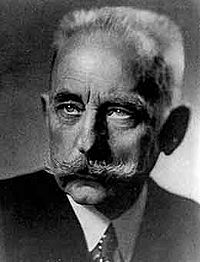- Max Bodenstein
-
Max Bodenstein 
Max BodensteinBorn July 15, 1871
Magdeburg, GermanyDied September 3, 1942
Berlin, GermanyResidence Germany, Nationality German Institutions University of Leipzig,
Humboldt University of Berlin,
University of Hanover,Alma mater University of Heidelberg Doctoral advisor Victor Meyer, Known for “Bodenstein-number”, a special type of Peclet number Max Ernst August Bodenstein (born July 15, 1871 in Magdeburg - died September 3, 1942 in Berlin) was a German physical chemist known for his work in chemical kinetics. He was first to postulate a chain reaction mechanism and that explosions are branched chain reactions, later applied to the atomic bomb.
Contents
Career
He received his PhD with the theme: "Zersetzung des Jodwasserstoffes in der Hitze" (Degradation of hydrogen iodide in hot temperature) with Victor Meyer at the University of Heidelberg.
He also studied decomposition of hydrohalic acids and their formation. Furthermore Bodenstein studied catalysis in flowing systems and discovered diffusion controlled catalytic reactions and photochemical reactions with Karl Liebermann at the Technical University of Berlin and with Walter Nernst at the University of Göttingen. After having returned to the University of Heidelberg in the year 1899 he habilitated with the theme: "Gasreaktionen in der chemischen Kinetik" (Reaction of Gas in the chemical kinetics).
In 1904 he was firstly appointed as honorary professor at the physicochemical institute from Wilhelm Ostwald at the University of Leipzig before furthermore in 1906 he was called to become associate professor at the University of Berlin and senior manager of the physicochemical institute of Walter Nernst. In 1908 he decided to change to the University of Hanover where he was appointed professor in ordinary and director of the electrochemical institute. Finally in 1923 he went back to Berlin where he accepted to be director of the physicochemical institute after the retirement of Walter Nernst.
Max Bodenstein was also co-operator with the "German Atomgewichts-Kommission" (German Commission of Atomic Weights), co-editor of the journal "Physikalische Chemie" (Physical chemistry) and since 1924 ordinary member in the German Academy of Sciences Leopoldina.
He died in Berlin. His tomb is at the cemetery Berlin-Nikolassee. A tablet commemorating Bodenstein and Walther Nernst was placed in 1983.[1]
Awards
In 1936 he was awarded the "August Wilhelm von Hofmann votive medal" from the "German Chemical Society". Furthermore he became honorary doctor of science of the University of Princeton and Dr.-Ing. E.h. (honorary doctor of engineering).
Special case and literature
- Chemische Kinetik. Ergebnisse der exakten Naturwiss., Berlin 1922; I., page 197-209,
- Photochemie. Ergebnisse der exakten Naturwiss., Berlin 1922; I, page 210-227,
- Completed references of his works in the library of Berlin-Brandenburgische Akademie der Wissenschaften:[2]
- Completed references of his works in the Wiley Interscience:[3]
- Works of Max Bodenstein in the German National Library [4]
The Bodenstein number, a special type of Peclet number that is often used to describe axial mixing in so-called axial-dispersion models, is named after him.
References
- ^ Image of commemorative tablet
- ^ works in library of Berlin-Brandenburgische Akademie der Wissenschaften[1]
- ^ Works in Wiley Interscience[2]
- ^ Max Bodenstein in the German National Library catalogue (German)
External links
Categories:- German chemists
- German scientists
- University of Leipzig faculty
- University of Hanover faculty
- Humboldt University of Berlin faculty
- 1871 births
- 1942 deaths
Wikimedia Foundation. 2010.
